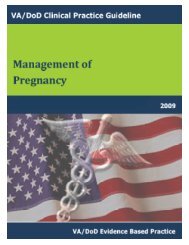DM Full Guideline (2010) - VA/DoD Clinical Practice Guidelines Home
DM Full Guideline (2010) - VA/DoD Clinical Practice Guidelines Home
DM Full Guideline (2010) - VA/DoD Clinical Practice Guidelines Home
You also want an ePaper? Increase the reach of your titles
YUMPU automatically turns print PDFs into web optimized ePapers that Google loves.
Version 4.0<br />
RATIONALE<br />
<strong>VA</strong>/<strong>DoD</strong> <strong>Clinical</strong> <strong>Practice</strong> <strong>Guideline</strong><br />
for the Management of Diabetes Mellitus<br />
Numerous controlled studies (randomized trials and meta-analyses)have examined either glucose lowering or insulin<br />
infusion in patients with critical illness and acute myocardial infarction. The questions addressed in these studies and<br />
the findings produced vary greatly. Controlled trials are lacking in patients admitted to general medical/surgical<br />
wards and with acute stroke, although high quality observational studies do exist for these populations. While there<br />
is little direct evidence specifically evaluating a blood glucose of < 180 mg/dl versus higher levels, the totality of<br />
evidence and the importance of avoiding abnormalities in fluid status from glucosuria, make this a prudent and safe<br />
upper limit for blood glucose level.<br />
DISCUSSION<br />
Glycemic control<br />
Randomized trials examining glycemic control and/or insulin therapy are limited to the study of hospitalized patients<br />
with severe illness (ICU, acute myocardial infarction, acute stroke). There have been no controlled trials conducted<br />
in other settings. However, numerous observational studies, some of which are well controlled, have demonstrated a<br />
strong relationship between hyperglycemia and mortality or morbidity (Baker et al., 2006; Bruno et al., 2008;<br />
Falciglia et al., 2009; Kosiborod et al., 2005; McAlisyter et al., 2005; Pomposelli et al., 1998; Umpierrez et al.,<br />
2002).<br />
Tight glycemic control<br />
The term “tight” glycemic control is not uniformly defined in the literature, and this has led to confusion in<br />
discussions of published evidence on this topic. Although some studies have described even targets of glucose <<br />
180 mg/dl as “tight”, the most recognized concept of tight control was introduced by Van den Berghe et al. in a<br />
randomized trial of surgical ICU (SICU) patients that examined the effects of continuous insulin infusion to achieve<br />
a target glucose of 80-110 mg/dl (Van den Berghe et al., 2001). The investigators demonstrated that establishing<br />
normoglycemia resulted in substantial reductions in hospital and ICU mortality, bloodstream infections, renal<br />
insufficiency, and the need for mechanical ventilation and blood transfusions. Despite the enthusiasm for adopting<br />
tight glycemic control following publication of this study, subsequent trials have been unable to reproduce these<br />
results. The same investigators conducted a similar study in patients admitted to the medical ICU (MICU) (Van den<br />
Berghe et al., 2006a). Because the greatest benefit in the SICU study was observed in patients who remained in<br />
intensive care for over 5 days, the investigators powered the MICU study to demonstrate improved outcomes in<br />
those staying over 3 days. In this group, a significant decrease in mortality was observed, with absolute reductions<br />
comparable to their study of SICU patients. However, no significant mortality difference was demonstrated in the<br />
intent-to-treat or short-stay groups, although improvements for other important outcomes such as decreased<br />
incidence of renal insufficiency, accelerated weaning of mechanical ventilation, and shortened length of stay were<br />
demonstrated in the intent–to-treat group. Given the lack of mortality benefit in the short-stay group and the inability<br />
to predict how long a patient would require care, these results raised some debate about the overall benefits of tight<br />
glycemic control and whether it should be initiated on admission. Van den Berghe et al. performed a subsequent<br />
analysis in which they pooled data from their two previously published SICU and MICU studies, demonstrating that<br />
tight glycemic control not only reduced mortality in the long-stay group but also in the entire (intent-to-treat) cohort<br />
(Van den Berghe et al., 2006b). Mortality rates in the first 3 days of ICU care were similar.<br />
The VISEP trial was a four-arm study examining both fluid resuscitation and tight glycemic control (80-110 mg/dl)<br />
in ICU patients with severe sepsis (Brunkhorst et al., 2008). The trial was stopped early due to high rates of<br />
hypoglycemia (17% vs. 4%). Although it did not demonstrate a mortality benefit from tight glycemic control, the<br />
trial was underpowered with only 537 subjects included in the final analysis. The recently published NICE-SUGAR<br />
trial has been able to shed some light on tight glycemic control as it included over 6000 patients at surgical and<br />
medical ICUs throughout Australia, New Zealand and Canada (Finfer et al., 2009). The investigators found no<br />
reduction in 90-day mortality (primary outcome) in the study group receiving tight control (mean glucose 115<br />
mg/dl) versus the control group (mean glucose 144 mg/dl). It was also noted that although there was no significant<br />
difference in hospital or 28-day mortality between the 2 groups, there were significantly more deaths at 90 days in<br />
the intensively treated group, raising many questions about the possible causative factors of death at 90 days after 4<br />
days of intensive glucose control.<br />
There is little evidence from controlled trials that specifically addresses glycemic control in patients with acute<br />
stroke. The largest published trial examining tight glycemic control after acute stroke is the UK Glucose in Stroke<br />
Trial (GIST) that examined the effects of a 24-hour intervention with GIK infusion to keep blood glucose 72-126<br />
Module G: Glycemic Control Page 69
















